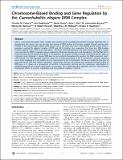Chromosome-Biased Binding and Gene Regulation by the Caenorhabditis elegans DRM Complex
Author(s)
Tabuchi, Tomoko M.; Deplancke, Bart; Osato, Naoki; Zhu, Lihua J.; Barrasa, M. Inmaculada; Harrison, Melissa M.; Walhout, Albertha J. M.; Hagstrom, Kristen A.; Horvitz, Howard Robert; ... Show more Show less
DownloadTabuchi-2011-Chromosome-Biased Bi.pdf (3.247Mb)
PUBLISHER_CC
Publisher with Creative Commons License
Creative Commons Attribution
Terms of use
Metadata
Show full item recordAbstract
DRM is a conserved transcription factor complex that includes E2F/DP and pRB family proteins and plays important roles in development and cancer. Here we describe new aspects of DRM binding and function revealed through genome-wide analyses of the Caenorhabditis elegans DRM subunit LIN-54. We show that LIN-54 DNA-binding activity recruits DRM to promoters enriched for adjacent putative E2F/DP and LIN-54 binding sites, suggesting that these two DNA–binding moieties together direct DRM to its target genes. Chromatin immunoprecipitation and gene expression profiling reveals conserved roles for DRM in regulating genes involved in cell division, development, and reproduction. We find that LIN-54 promotes expression of reproduction genes in the germline, but prevents ectopic activation of germline-specific genes in embryonic soma. Strikingly, C. elegans DRM does not act uniformly throughout the genome: the DRM recruitment motif, DRM binding, and DRM-regulated embryonic genes are all under-represented on the X chromosome. However, germline genes down-regulated in lin-54 mutants are over-represented on the X chromosome. We discuss models for how loss of autosome-bound DRM may enhance germline X chromosome silencing. We propose that autosome-enriched binding of DRM arose in C. elegans as a consequence of germline X chromosome silencing and the evolutionary redistribution of germline-expressed and essential target genes to autosomes. Sex chromosome gene regulation may thus have profound evolutionary effects on genome organization and transcriptional regulatory networks.
Date issued
2011-05Department
Massachusetts Institute of Technology. Department of BiologyJournal
PLoS Genetics
Publisher
Public Library of Science
Citation
Tabuchi, Tomoko M. et al. “Chromosome-Biased Binding and Gene Regulation by the Caenorhabditis Elegans DRM Complex.” Ed. Jeannie T. Lee. PLoS Genetics 7.5 (2011) : e1002074.
Version: Final published version
ISSN
1553-7404
1553-7390